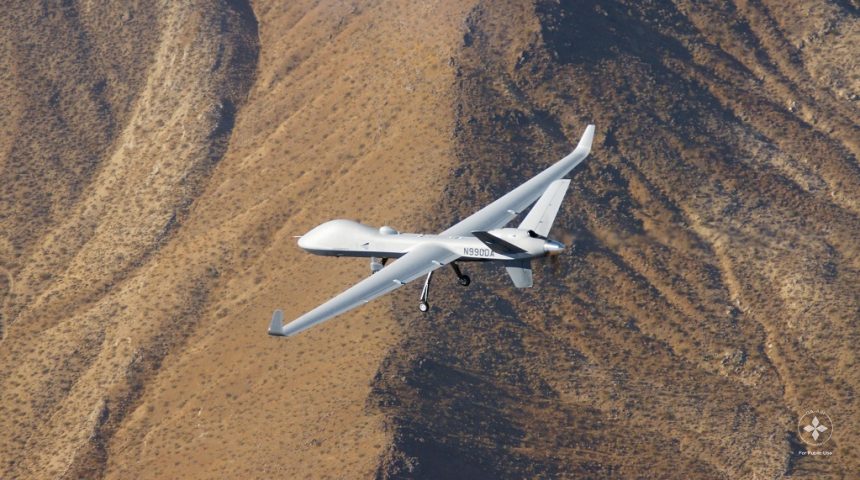The New Remotely Piloted Aircraft System Will Replace The British MQ-9A Reapers.
General Atomics (GA-ASI) performed the first flight of the Royal Air Force’s new Remotely Piloted Aircraft System, the Protector RG Mk1 (RG stands for Reconnaissance/Ground attack), on Sept. 25, 2020. The new aircraft is the British variant of the MQ-9B SkyGuardian; it is actually the fourth MQ-9B to be built but the first one owned by the United Kingdom Ministry of Defence, and for this reason, it has been designated UK1. The first three SkyGuardians are company-owned airframes that will support the certification process.
The first Protector RG1, which will remain in the U.S. to complete the Royal Air Force’s test and evaluation program with provisional registration N990DA, will be formally delivered in the summer of 2021, while the first operational aircraft will be delivered in 2023 and will enter active service in 2024, replacing the RAF’s current MQ-9A Reaper fleet. Considered a step change in capability for the RAF, the new cutting-edge platform will be capable of being flown anywhere in the world while being operated by personnel located at their home base at RAF Waddington, according to the press release.
Defence Minister Jeremy Quin said after the important milestone: “The inaugural flight of the UK’s first Protector is an exciting and welcome step in the development of our ground-breaking fleet. With increased range and endurance, greater ISR and weapons capacity and improved weather resilience, Protector will play a vital intelligence and deterrent role in countering future threats.”
The Protector RG1 has been designed to meet NATO and UK safety certification standards to allow operations in civilian airspace, in particular NATO’s airworthiness type-certification standard STANAG 4671. For this reason, the RPAS is provisioned for the GA-ASI-developed Detect and Avoid System (DAAS), which consists of GA-ASI’s Due Regard Radar (DRR) and processor and a Traffic Alert and Collision Avoidance System (TCAS), to enhance safety of operations in civil and military airspace. Advanced anti-icing and lightning protection and a damage tolerant airframe will allow the aircraft to operate also in adverse weather conditions.

As for the mission-related features, the only available info at the moment is presence onboard of enhanced data links and an offensive capability based around the UK-made Brimstone missile and Paveway IV laser guided bomb. Compared to the MQ-9A Reaper, the Protector has two additional hardpoints for weapons, for a total of six.
Group Captain Shaun Gee, the RAF’s Director Air ISTAR Programmes, said: “Protector will be deployed in wide-ranging Intelligence, Surveillance, Target Acquisition and Reconnaissance (ISTAR) operations where its ability to fly consistently for up to 40 hours will offer a vastly improved ISTAR capability. Given that it is designed to fly in non-segregated, civil airspace, the Protector RPAS will be able to respond rapidly and offer flexibility, delivering many types of military or civil authority support missions, including search and rescue.”
According to the official statement, the Protector will also be available, if requested, to support civilian search and rescue and disaster response missions.
The UK MoD currently has three Protectors on order, with an option for 13 additional aircraft for a planned fleet of 16 RPASs. The basic version of the aircraft, the MQ-9B, is considered the most advanced RPAS developed by General Atomics, and is currently offered in both a SkyGuardian and a maritime SeaGuardian configuration, but the UK opted for a specific custom configuration. The MQ-9B has been offered also to Australia and Belgium, with the latter agreeing in August to a Bilateral Statement of Intent with the UK to cooperate on training, maintenance, logistic support, interoperability and capability enhancement.
As a sidenote, in 2018, the MQ-9B departed from General Atomics’ Flight Test and Training Center in Grand Forks, North Dakota, and arrived 24 hours later without stopovers at RAF Fairford to participate to the Royal International Air Tattoo 2018. This was the first time a Medium Altitude Long Endurance (MALE) RPAS flew the trans-Atlantic route.
Historic #transatlantic flight from North Dakota to Gloucestershire will take over 20 hours and be the first #RPAS to enter UK airspace under beyond line of sight control #unmannedandunafraid #SkyGuardianhttps://t.co/XSTmbvjrAq pic.twitter.com/8g1pjp56gn
— GA-ASI (@GenAtomics_ASI) July 7, 2018
Following the @GenAtomics_ASI #SkyGuardian to @airtattoo in the first #transatlantic flight by a Medium altitude, long-endurance RPA integrated in flight traffic. https://t.co/QuGB8ximJ9 #MQ9BAtlantic pic.twitter.com/szkPkJexTe
— Flightradar24 (@flightradar24) July 10, 2018









